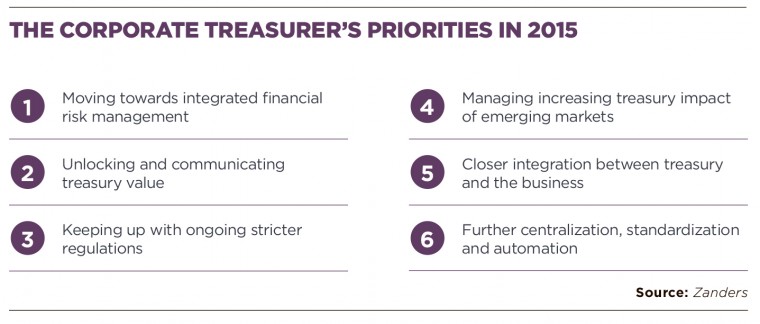The global financial crisis of 2008 radically altered how businesses ran their finance teams. As a greater onus was placed on cash management, balance sheet monitoring and liquidity, the role of the corporate treasury team became more significant than ever.
Since the crisis, global regulators have introduced swathes of new regulations which stretch across business sectors and this has led to treasury teams becoming more influential in organisations around the world.
Most recently, the European Commission outlined a new set of corporation tax transparency measures, targeting those companies attempting to avoid corporation tax through transfer pricing techniques.
This follows extensive work by the Organisation for Economic Co-operation and Development (OECD) on transfer pricing and corporate base erosion to counter organisations seeking to restructure and thereby limit or avoid tax.
These recent examples are just two policy sets where global businesses have relied on their corporate treasurers to assess the impact and manage the risk. And, with the increasing speed of globalisation, their remit has arguably never been more important.

David Stebbings, director of treasury advisory at consultancy group PwC, explains: “The role and the responsibilities of treasury beyond the ‘departmental wall’ have transformed beyond all recognition since the financial crisis.
“In the years following the crisis, treasury teams have expanded their influence more widely across the organisation, getting closer to business operations and allowing them to bring more insight into the risks facing the business as it grows and competes in evermore global markets.”
Globalisation is a key reason why leadership teams consult corporate treasurers more than before. As businesses expand into new areas, corporate treasury teams can often be well equipped to offer advice on challenges arising from regulation, currencies and the need to work with new banking partners.
But globalisation of business is only part of the story. The financial crisis caused businesses to begin challenging the credit worthiness of their banking partners and the cost of the services they offer, and led to sustained volatility in the money markets.
“This has led to an increasing need for agility in managing banking partners, the management of excess cash, and the development of alternative sources of finance and cash services,” says Mr Stebbings.
He says the increasing focus on value for money and cash management has meant many businesses, not just those with high gearing, are focusing on cash as a key performance measure.
“Cash is king. Therefore access to cash and ability to move and manage cash effectively has become more important,” he says.
It’s certainly true that recent exchange rate movements of the Russian rouble, Swiss franc and euro have meant businesses require vigilant corporate treasurers.
Bob Stark, vice president of strategy at treasury management group Kyriba, explains: “Expanding the business globally introduces significant risk to an organisation’s cash flow and financial assets.
“Treasurers must protect against changes in currency rates, liquidity risk in each geography, regulatory risk heightened by the multitude of regions the organisation operates in, and of course operational errors and fraud that commonly increase as firms decentralise their processes and control internationally.”
In addition, corporate treasury teams have found themselves having to deal with increasing volumes of regulation, particularly since the 2008 crash. What had predominantly been affecting financial services companies only, soon spread to most other sectors.
Accounting standards, European Market infrastructure regulation, Dodd Frank and BEPS (base erosion and transfer pricing rules) are just some examples of regulatory changes which have been a fixture on corporate treasurers’ to-do lists in recent months.
In recent years, corporate treasury teams have transitioned from a standalone function to the role of strategic partner
Corporate treasurers’ understanding of these changing rules and regulations are a major reason why their services are being called upon by board members. Niclas Neglen, chief financial officer at GE Capital UK, says: “In a volatile world, with changing external regulations… the boardroom should take an active interest in today’s corporate treasury function.
“As a business unit, it provides strategic input into the key risks facing a business, including funding availability. It is an essential function that supports the growth agenda, helping prioritise capital across a business and maximising the potential of the balance sheet through the identification of multiple funding alternatives.
“In recent years, corporate treasury teams have transitioned from a standalone function to the role of strategic partner. For this reason, it is critical that the corporate treasury team understand the short-term tactical and long-term strategic goals.”

While the transition period since the credit crisis may have been painful for many companies, it is likely that the corporate treasury teams of tomorrow will have a much more holistic view of companies’ risk positions.
The level of detail that treasurers will be able to provide will be more comprehensive and far beyond the traditional boundaries of simple cash positions, according to analysts at consultancy Deloitte.
Karlien Porre, co-leader at Deloitte’s London-based treasury advisory service, says: “Key performance indicators will focus more on the effectiveness of risk management strategy and treasury departments will become more proactive in managing regulatory changes.
“The treasury department of the future will rely heavily on treasury technology to operate as efficiently as possible and empower them to take on a more important role in the organisation.”
Ms Porre says the emerging trend now is that real-time data management is likely to become commonplace in all businesses and not just in those with the largest budgets.
She says: “The increasing use of instrument portfolios and unintended consequences of regulation will play a part in driving tomorrow’s treasury department to be far more focused on counterparty, liquidity and operational risk management.”


